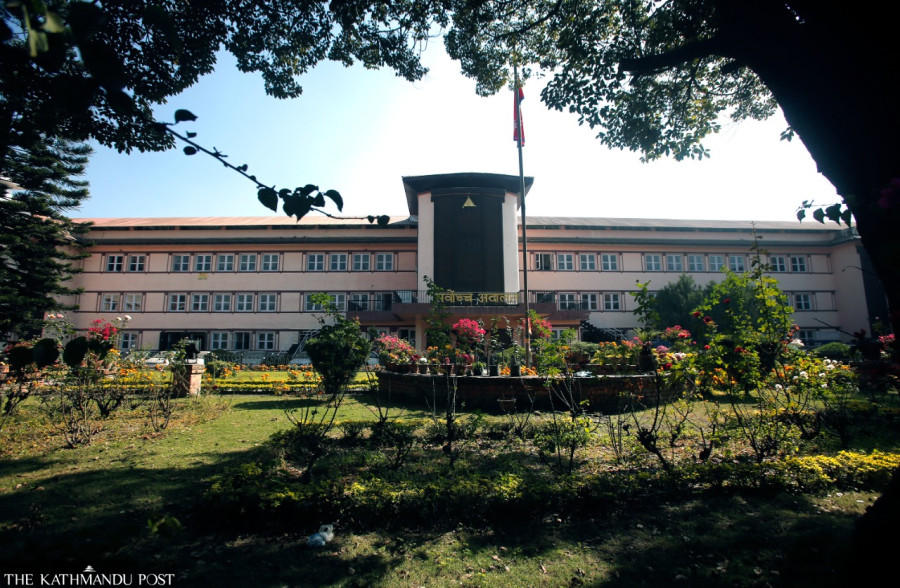National
Supreme Court standoff takes a new turn as four judges return to work
Protesting lawyers say they will start calling out all those justices who side with Chief Justice Rana.
Tika R Pradhan
A day after five of the agitating justices decided to attend benches, four of them heard cases other than habeas corpus on Tuesday, in what could put pressure on their colleagues in the Supreme Court and could redefine the protests by lawyers who have made Chief Justice Cholendra Shumsher Rana’s resignation their bottom line.
The four justices’ return to benches comes after three weeks of deadlock in the judiciary and a day after Rana’s invitation to legal practitioners to find a solution through dialogue.
“Actually, we were also preparing to return to benches by introducing a system of drawing lots for case assignments, but they made a decision in a haste,” said a senior justice, who has not participated in the hearings yet. “We will continue our meeting on Wednesday as well and try to finalise the draft to amend the regulations for introducing the system of drawing lots.”
According to the justice, once the full court endorses the amendment to the regulations, the system of drawing lots would be in place and then they would have an excuse to return to benches.
Four of the five justices who heard the cases on Tuesday had snubbed a meeting called by the Nepal Bar Association and Supreme Court Bar Association on Monday and Tuesday as well. Ten other justices who were present at the Supreme Court on Monday, however, attended the lawyers’ meeting.
The Nepal Bar Association, meanwhile, has warned that lawyers would launch a struggle against the justices who side with Chief Justice Rana and become a cause for his longer stay in the Supreme Court.
“We will have to launch a struggle against the justices as well,” said Lilamani Poudel, general secretary of Nepal Bar, while addressing Tuesday’s protest of lawyers in front of the Supreme Court.
Of the 16 justices present at the Supreme Court on Tuesday, two division benches, one of Bam Kumar Shrestha and Manoj Kumar Sharma, and the other of Tej Bahadur KC and Kumar Regmi, heard four and 28 cases respectively, according to the cause list prepared by the chief justice for the day.
The fifth justice who on Monday did not attend the meeting of lawyers was Kumar Chudal.
Chudal on Tuesday heard one habeas corpus case with Justice Prakash Dhungana.
The Supreme Court currently has 20 justices, including the chief justice.
All of them had on October 25 refused to attend a meeting called by Rana, marking the beginning of their protest against the chief justice. The Supreme Court Bar Association and Nepal Bar Association then joined hands to demand Rana’s resignation, alleging that he is the source of all the ills in the judiciary.
Rana has maintained that he would not step down because there were calls for his resignation and that he would rather face the constitutional procedure, meaning an impeachment motion. An impeachment motion against the chief justice can be filed by lawmakers in Parliament, but parties have not made any move yet.
Politicians rather have argued that a solution to the crisis in the judiciary should be found from within.
On Tuesday, a meeting of the high-level coordination committee formed by five ruling parties discussed the crisis in the judiciary.
According to a statement issued by the coordination committee after the meeting, the meeting took note of the stalemate in the Supreme Court and expected all stakeholders to take initiatives to find a solution to the ongoing crisis in the judiciary at the earliest so as to save the independence, dignity, credibility and impartiality of the judiciary.
The parties in the ruling coalition so far have not made any concrete statements on whether they would make any move towards filing an impeachment motion. Their reluctance stems largely from fears, as multiple cases related to their leaders are pending in the Supreme Court.
With justices divided and lawyers yet to decide on their next move, it does not look like the crisis in the judiciary will end anytime soon.
“The recent development could further damage the judiciary,” said Balram KC, a former Supreme Court justice. “Some of the justices decided to abandon the campaign before it reached a logical conclusion. This does look good for the health of the judiciary, which by now we all know very well that it needs serious and immediate reforms.”
Now that four justices have already returned to benches and the rest are discussing the next move, the ball is in lawyers’ court.
Lawyers have been saying that they will continue their protests against Chief Justice Rana until he steps down. They concluded their second phase of protest on Tuesday.
After a scuffle with police on Thursday, the lawyers had decided not to let Rana enter the Supreme Court. But Rana managed to dodge the lawyers’ protest to reach his office not only on Friday, but also on Sunday, Monday and Tuesday.
“We will continue our meetings on Wednesday as well,” said Purna Man Shakya, chair of the Supreme Court Bar Association. “We will hold talks with the five justices who attended the benches today in the presence of the Nepal Bar Association.




 18.12°C Kathmandu
18.12°C Kathmandu















